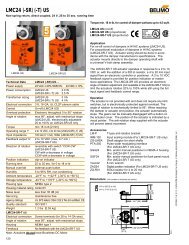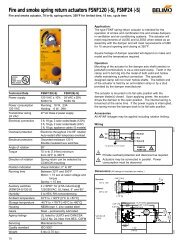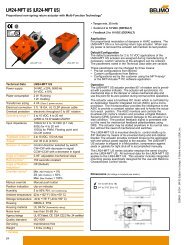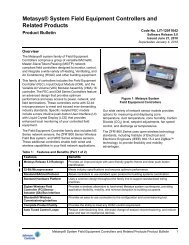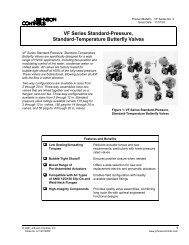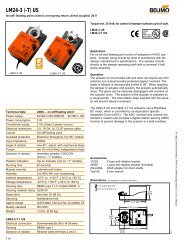MS4PMUHVT Multi-Stage Electronic Temperature Control with ...
MS4PMUHVT Multi-Stage Electronic Temperature Control with ...
MS4PMUHVT Multi-Stage Electronic Temperature Control with ...
You also want an ePaper? Increase the reach of your titles
YUMPU automatically turns print PDFs into web optimized ePapers that Google loves.
FCC Compliance Statement<br />
This equipment has been tested and found to<br />
comply <strong>with</strong> the limits for a Class A digital device<br />
pursuant to Part 15 of the FCC Rules. These limits<br />
are designed to provide reasonable protection<br />
against harmful interference when the equipment is<br />
operated in a commercial environment. This<br />
equipment generates, uses, and can radiate radio<br />
frequency energy and, if not installed and used in<br />
accordance <strong>with</strong> the instruction manual, may cause<br />
harmful interference to radio communications.<br />
Operation of this equipment in a residential area is<br />
likely to cause harmful interference, in which case<br />
the user will be required to correct the interference<br />
at his/her own expense.<br />
Canadian Compliance Statement<br />
This digital apparatus does not exceed the Class A<br />
limits for radio noise emissions from digital<br />
apparatus set out in the Radio Interference<br />
Regulations of the Canadian Department of<br />
Communications.<br />
Application<br />
IMPORTANT: The <strong>MS4PMUHVT</strong> <strong>Multi</strong>-<strong>Stage</strong><br />
<strong>Temperature</strong> <strong>Control</strong> is intended to control<br />
equipment under normal operating conditions.<br />
Where failure or malfunction of the <strong>MS4PMUHVT</strong><br />
control could lead to an abnormal operating<br />
condition that could cause personal injury or<br />
damage to the equipment or other property, other<br />
devices (limit or safety controls) or systems (alarm<br />
or supervisory systems) intended to warn of, or<br />
protect against, failure or malfunction of the<br />
<strong>MS4PMUHVT</strong> control must be incorporated into<br />
and maintained as part of the control system.<br />
The <strong>MS4PMUHVT</strong> control provides direct control in<br />
many applications:<br />
• cooling tower pump and/or fan control<br />
• rooftop heating or cooling units<br />
• boiler or pump control<br />
• space temperature control<br />
• compressor or chiller staging<br />
The <strong>MS4PMUHVT</strong> control has four heavy-duty<br />
relays. See electrical ratings in Table 6 for more<br />
information.<br />
Operation<br />
Mode Selection<br />
Mode Selection allows selection of one of several<br />
modes:<br />
• Direct mode for cooling applications<br />
• Reverse mode for heating applications<br />
• Deadband mode for applications requiring cooling<br />
and heating <strong>with</strong> a common setpoint and a<br />
deadband<br />
• Independent Setpoint mode for applications<br />
requiring cooling and heating <strong>with</strong> one setpoint for<br />
heating and a second (independent) setpoint for<br />
cooling<br />
<strong>Stage</strong> <strong>Control</strong><br />
Several settings define the control functions for the<br />
stages:<br />
• Setpoints and Differentials setting establish the<br />
temperature-control ranges.<br />
• Cycle Delays establish a set time interval between<br />
heating or cooling cycle restarts to avoid excessive<br />
cycling.<br />
• Soft Start controls the rate at which temperature<br />
approaches the Setpoint on power-up or when<br />
Binary Input Option 3 is selected. This feature is<br />
useful when starting equipment where merchandise<br />
in the controlled space needs to be slowly brought to<br />
the desired temperature (Setpoint). If this feature is<br />
used, the control activates up to four stages in<br />
succession to slowly bring the sensed temperature<br />
to the desired temperature (Setpoint) at the<br />
user-selected rate.<br />
Alarm Management<br />
Several settings define the control functions for alarms:<br />
• High and Low <strong>Temperature</strong> Alarms provide<br />
notification of temperatures that exceed<br />
user-designated high and low limits.<br />
• Alarm Time Delay keeps short-duration<br />
temperature changes from triggering an alarm.<br />
• Alarm Differential keeps the alarm from cycling<br />
rapidly on and off due to minor temperature<br />
fluctuations.<br />
• Alarm Codes assist in troubleshooting.<br />
2 <strong>MS4PMUHVT</strong> <strong>Multi</strong>-<strong>Stage</strong> <strong>Electronic</strong> <strong>Temperature</strong> <strong>Control</strong> <strong>with</strong> Relay Pack Product/Technical Bulletin




